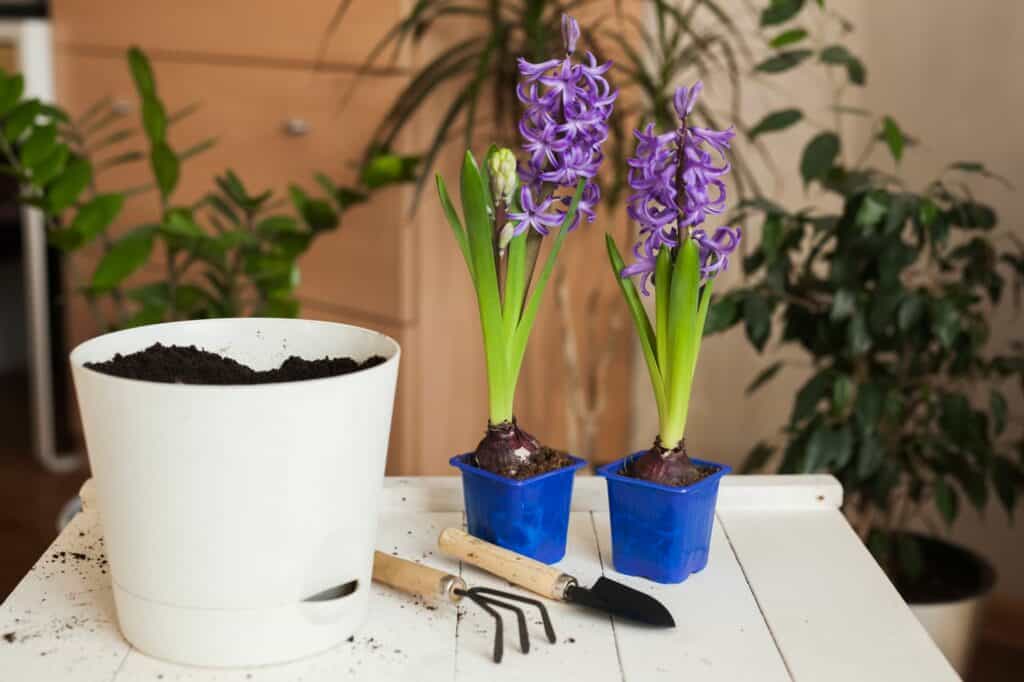Knowing how often to repot a plant can be a bit tricky, but it is an essential part of keeping your indoor plants healthy.
Repotting helps plants grow better by providing them with fresh soil, more space for their roots to grow, and better drainage. However, it is important to know when to repot, how to do it correctly, and what to expect after repotting.
The frequency of repotting varies depending on the type of plant, its growth rate, and its size. Some plants grow quickly and need to be repotted every year, while others can go several years without needing a new container.
It is important to recognize the signs that a plant needs repotting, such as roots growing out of the drainage holes, soil drying out too quickly, or the plant becoming too large for its container.
Key Takeaways:
- Repotting is an essential part of keeping indoor plants healthy by providing fresh soil, more space for roots, and better drainage.
- The frequency of repotting varies depending on the type of plant, its growth rate, and its size.
- Signs that a plant needs repotting include roots growing out of the drainage holes, soil drying out too quickly, or the plant becoming too large for its container.
Don’t miss this related post about repotting:
Repotted Plant Dying: 3 Causes, Solutions & Best Care Tips

Understanding the Importance of Repotting
Repotting is an essential aspect of plant care that is often overlooked. It involves transferring a plant from its current pot to a larger one or replacing the soil in the same pot.
The primary purpose of repotting is to provide the plant with more space to grow and access to fresh nutrients.
When a plant outgrows its current pot, its roots become cramped, and the soil loses its nutrients.
This can lead to stunted growth, yellowing leaves, and even death. Repotting allows the plant to spread its roots and absorb more water and nutrients, which in turn promotes healthy growth.
Houseplants should be repotted every 12 to 18 months, but this timeline may vary depending on the plant’s growth rate and size.
Slow-growing plants like succulents can be repotted every two to four years, while fast-growing plants may need to be repotted more frequently.
It is essential to choose the right pot size when repotting. A pot that is too small will restrict the plant’s growth, while a pot that is too large can cause the soil to retain too much moisture, leading to root rot.
The new pot should be only one size larger than the current pot to avoid overwhelming the plant.
Repotting can also be an opportunity to inspect the plant for any signs of pests or disease. By removing the plant from its current pot, you can check the roots and soil for any issues and take corrective action if necessary.
Repotting is a critical aspect of plant care that should not be overlooked. It provides the plant with more space to grow and access to fresh nutrients, which promotes healthy growth.
Houseplants should be repotted every 12 to 18 months, and the new pot should be only one size larger than the current pot.
Repotting also allows for the inspection of the plant for any signs of pests or disease.
Ideal Time to Repot
Plants typically need to be repotted every 12 to 18 months, depending on the type of plant and its growth rate.
The best time to repot a plant is when it is actively growing, usually in the early spring or early summer.
This is when the plant is producing new growth and can easily recover from the stress of repotting.
During the winter, plants are usually dormant and not actively growing. Repotting during this time can cause stress to the plant and may even lead to root rot. It is best to avoid repotting during the winter unless it is absolutely necessary.
When repotting a plant, it is important to choose the right pot size. The new pot should be only slightly larger than the old pot, about 1-2 inches wider in diameter. This will allow the roots to have enough space to grow without being overwhelmed by too much soil.
It is also important to choose the right soil for the plant. Different plants have different soil requirements, so it is important to do some research to find out what type of soil your plant needs. Generally, a high-quality potting mix with good drainage is a good choice for most plants.
The ideal time to repot a plant is when it is actively growing, usually in the early spring or early summer. It is important to choose the right pot size and soil for the plant to ensure its health and growth. Avoid repotting during the winter unless it is absolutely necessary.
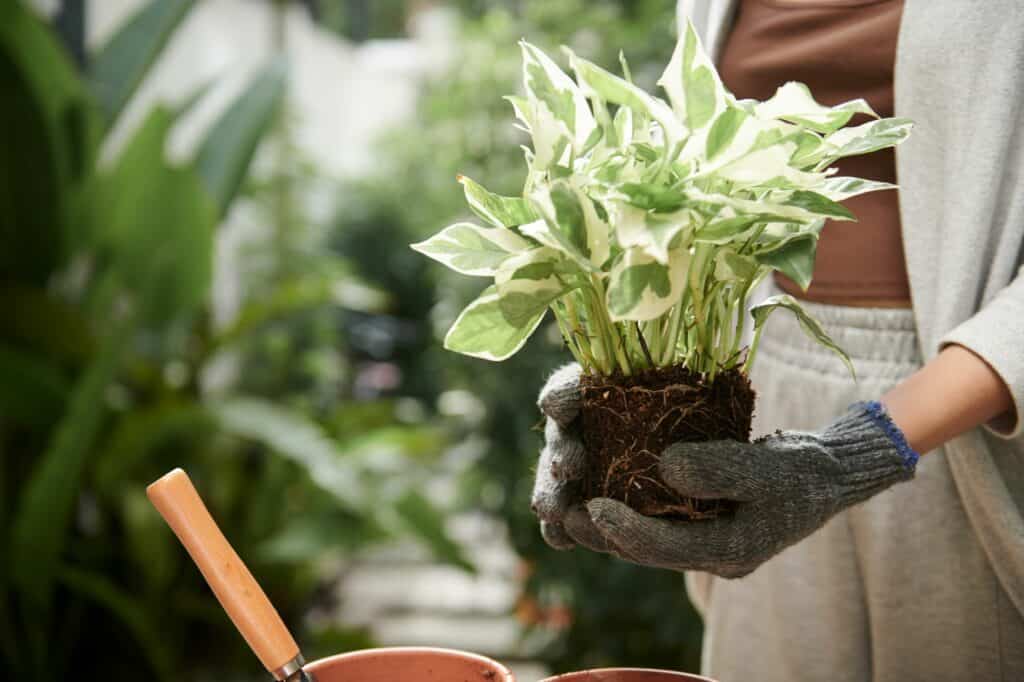
How Often Can You Repot a Plant
Plants may need to be repotted for various reasons, including to provide them with more space to grow, to replace old soil, or to address any root-bound issues.
Here are some signs to look out for to determine whether it’s time to repot your plant:
1. Stunted Growth
If your plant has stopped growing, it may be an indication that it needs more space to spread its roots.
The roots may have become too crowded in the current pot, making it difficult for the plant to absorb the necessary nutrients and water.
2. Limp or Ailing Plant
If your plant is looking limp or ailing, it may be a sign that it needs to be repotted. This could be due to the roots being compacted or the soil being depleted of nutrients.
Repotting the plant can provide it with fresh soil and more space for the roots to grow, which can help it recover.
3. Roots Growing Out of Drainage Holes
If you notice roots growing out of the drainage holes at the bottom of the pot, it’s a clear sign that the plant has outgrown its current container.
The roots are searching for more space to grow, and repotting the plant can provide them with the necessary room to spread out and thrive.
4. Lower Leaves Turning Yellow or Brown
If the lower leaves of your plant are turning yellow or brown, it may be a sign of root-bound issues. When the roots become too crowded, they can’t absorb the necessary nutrients, which can cause the lower leaves to die off.
Repotting the plant can provide it with fresh soil and more space for the roots to grow, which can help prevent further damage.
By recognizing the signs that your plant needs to be repotted, you can ensure that it has the necessary space and nutrients to grow and thrive.
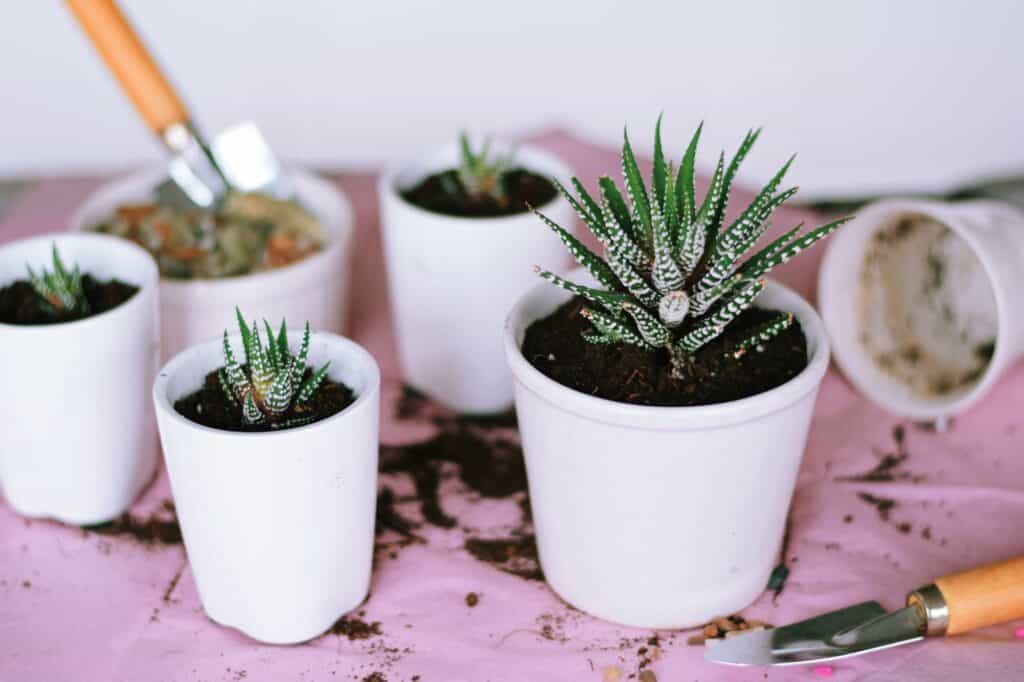
Choosing the Right Pot
Choosing the right pot is important when it comes to repotting a plant. The size and material of the pot can affect the growth and health of the plant.
When selecting a new pot, it is important to consider the following factors:
Size
When choosing a new pot, it is important to select a pot that is slightly larger than the current pot.
A pot that is too small can restrict the growth of the plant, while a pot that is too large can cause the soil to retain too much moisture, leading to root rot.
The new pot should be about 2 inches larger in diameter than the current pot.
Material
Pots can be made of various materials, including plastic, clay, terracotta, and decorative cache pots.
Plastic pots are lightweight and easy to clean, but they do not provide good insulation for the roots.
Clay and terracotta pots are porous and allow for better air circulation, but they can be heavy and breakable.
Decorative cache pots are typically used to cover a plastic or clay pot and can add a decorative touch to the plant.
Drainage
Proper drainage is essential for the health of the plant. The new pot should have drainage holes to allow excess water to drain out of the soil.
If the new pot does not have drainage holes, it is important to drill them before repotting the plant.
Style
The style of the pot can also be a factor to consider. A simple pot can complement the plant and allow it to be the focal point, while a decorative pot can add a pop of color or texture to the room.
When choosing a new pot for repotting a plant, it is important to consider the size, material, drainage, and style of the pot.
By selecting the right pot, the plant can thrive and continue to grow in a healthy environment.
Preparation for Repotting
Before repotting a plant, it is important to prepare everything needed to ensure a successful process. This includes preparing the plant, the new pot, and the potting mix.
First, check the plant’s roots for any signs of damage or disease. If there are any, it is best to trim them off with a sterilized knife or garden scissors.
Next, remove the plant from its current pot by gently tapping the sides of the pot or squeezing the sides to loosen the soil. If the plant is stuck, use a garden knife or trowel to loosen the soil around the edges.
Once the plant is out of the pot, inspect the root ball for any signs of overcrowding or root bound.
If the roots have grown too much and are tightly packed, it is time to repot. If not, it is best to wait until the plant outgrows its current pot.
Before placing the plant in its new pot, make sure the new pot has proper drainage holes to allow for proper drainage.
Cover the holes with a coffee filter or a piece of porous material to prevent soil from falling out. Then, add a layer of potting mix at the bottom of the pot.
When it comes to the potting mix, there are many options available, such as perlite, peat moss, sand, and organic potting soil.
Choose a mix that is appropriate for the type of plant being repotted. It is also important to consider the plant’s sunlight and humidity needs.
When filling the new pot with potting mix, make sure to leave enough space at the top for watering.
Once the potting mix is in place, gently place the plant in the pot, making sure it is centered and at the right height.
Fill in the gaps with more potting mix and gently press down to remove any air pockets.
After repotting, water the plant thoroughly and place it in an area with appropriate sunlight and humidity.
Use a watering can and a saucer to catch any excess water. It is important to avoid overwatering and to wait until the soil is dry before watering again.
By following these steps, repotting a plant can be a simple and successful process.
The Repotting Process
When it’s time to repot a plant, there are a few steps to follow to ensure the process goes smoothly.
The first step is to carefully remove the plant from its current container. This can be done by gently tipping the container to the side and sliding the plant out, or by carefully loosening the soil around the edges of the container and gently pulling the plant out.
Once the plant is out of its container, it’s important to examine the root system. If the roots are circling around the root ball, it’s a sign that the plant is root-bound and in need of an upgrade.
If the roots are healthy and white, there’s no need to trim them. However, if there are any brown or black roots, they should be trimmed away to prevent root rot.
The next step is to prepare the new container. It should be slightly larger than the previous container to give the plant room to grow. The new container should also have drainage holes to prevent overwatering.
Before placing the plant in the new container, add a layer of fresh potting soil to the bottom. This will help the plant adjust to its new environment.
Then, gently place the plant in the new container and fill in the gaps with fresh potting soil. Be sure to tamp down the soil gently to remove any air pockets.
After repotting, the plant may need some extra TLC. It’s important to water the plant thoroughly and keep it in a shaded area for a few days to help it adjust to its new surroundings.
It’s also a good idea to avoid fertilizing the plant for a few weeks to give it time to recover from the transplanting process.
Repotting a plant is a gentle process that requires attention to detail and care. By following these steps, a plant can thrive in its new container and continue to grow healthy and strong.
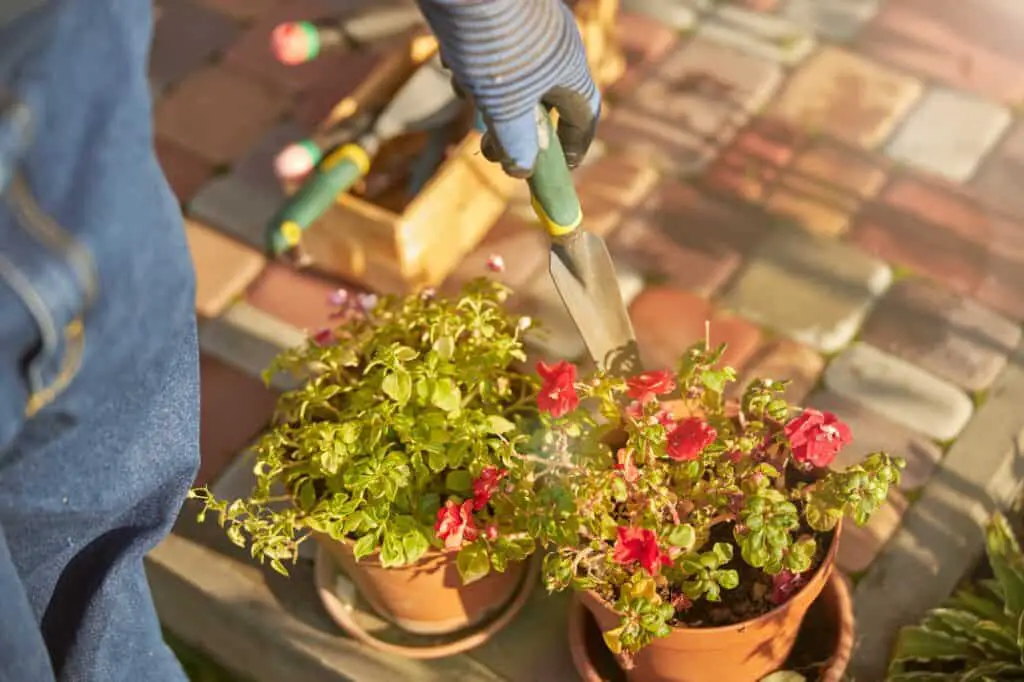
Post-Repotting Care
After repotting a plant, it is important to take care of it properly to ensure its health and growth. Here are some essential post-repotting care tips for your plants:
Watering
Watering is an essential part of post-repotting care. After repotting, the plant may need more water than usual to help it adjust to its new environment.
However, overwatering can lead to root rot, so it is important to water the plant only when the top layer of soil is dry to the touch.
Fertilizing
Fertilizing can help the plant recover from the stress of repotting. It is recommended to wait at least two weeks after repotting before fertilizing the plant.
This will give the plant time to adjust to its new environment and avoid fertilizer burn. Use a balanced fertilizer and follow the instructions on the package for the correct dosage.
Drying Out
After repotting, the plant may experience some stress and may need to dry out a bit before watering again.
This is especially true for plants that prefer well-draining soil. Check the soil moisture level regularly and avoid overwatering.
Species and Type of Plant
Different plant species have different needs when it comes to post-repotting care.
For example, snake plants, African violets, aloe, amaryllis, hoya, jade plants, and peace lilies all have different watering and fertilizing needs.
Research the specific needs of your plant to ensure it receives the proper care.
Fast-Growing Plants
Fast-growing plants may need to be repotted more frequently than slower-growing plants. Consider the size of the plant and the size of the pot when determining the frequency of repotting.
Proper post-repotting care is crucial for the health and growth of your plants. Water and fertilize the plant appropriately, allow it to dry out between waterings, and consider the specific needs of your plant species and type. With these tips, your plants will thrive in their new homes.
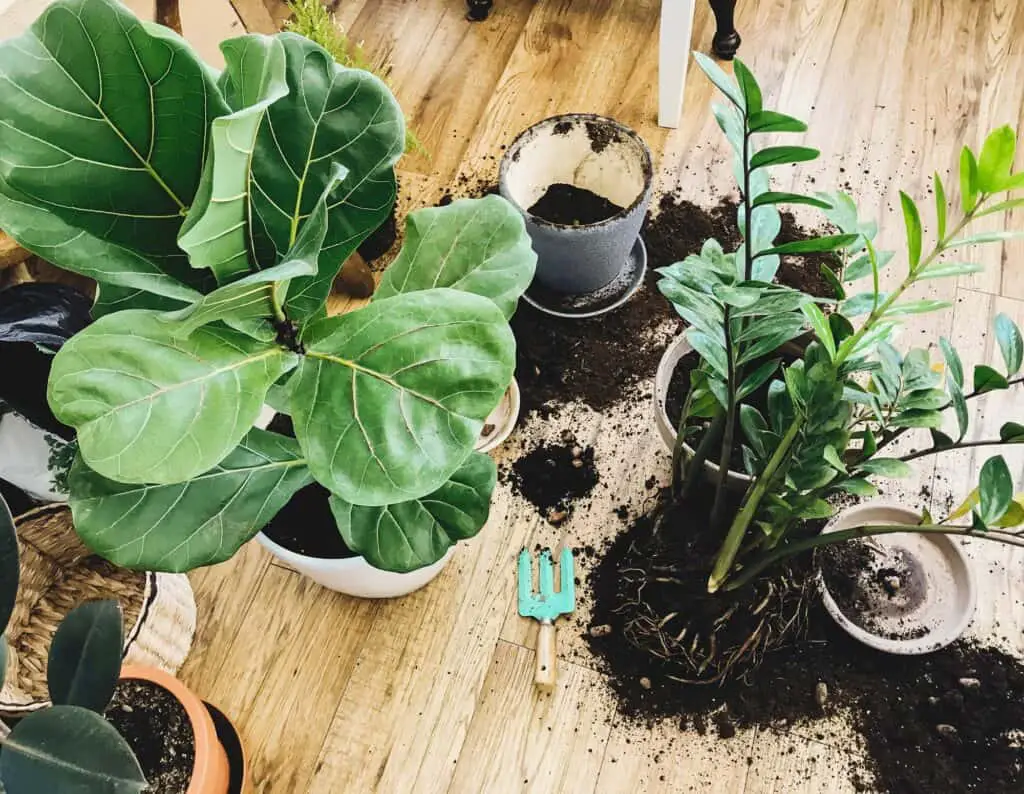
Special Considerations for Succulents
Succulents are a popular choice among plant enthusiasts due to their low maintenance and water requirements.
However, when it comes to repotting succulents, there are some special considerations to keep in mind.
Succulents prefer to be slightly pot-bound, meaning they like their roots to be snug in their container.
Therefore, it’s important to choose a pot that’s only slightly larger than their current one. A pot that’s too large can cause the soil to stay wet for too long, leading to root rot.
When repotting succulents, it’s important to use well-draining soil to prevent water from sitting in the roots.
A mix of potting soil and sand or perlite can help create the perfect balance of moisture retention and drainage.
Old soil can also be a problem for succulents, as it can become compacted and prevent water from draining properly.
Therefore, it’s important to replace the old soil with fresh soil when repotting.
It’s recommended to repot succulents every 2-3 years, or when the plant has outgrown its current container.
Signs that a succulent is pot-bound include roots growing out of the drainage holes, or the plant becoming top-heavy and falling over.
When repotting succulents, it’s important to choose a slightly larger pot, use well-draining soil, replace old soil, and repot every 2-3 years or when the plant has outgrown its current container.
By following these special considerations, succulent enthusiasts can ensure their plants stay healthy and thrive.
Addressing Common Issues and Diseases
Indoor plants are susceptible to a variety of diseases and issues that can impact their growth and health. Some of the most common issues include overwatering, underwatering, pests, and diseases.
Overwatering is a common problem that can lead to root rot and other issues. When a plant is overwatered, the roots become waterlogged and can’t absorb the nutrients they need to grow. This can lead to stunted growth, yellowing leaves, and even death. To avoid overwatering, it’s important to ensure that the plant’s growing medium is well-draining and that the plant isn’t sitting in standing water.
Underwatering is another common issue that can impact the health of indoor plants. When a plant doesn’t receive enough water, it can become dehydrated and wilt.
This can lead to yellowing leaves and stunted growth. To avoid underwatering, it’s important to ensure that the plant’s soil is consistently moist but not waterlogged.
Pests are another common issue that can impact indoor plants. Common pests include spider mites, mealybugs, and aphids.
These pests can cause damage to the plant’s leaves and stems, and can even kill the plant if left untreated.
To avoid pest infestations, it’s important to regularly inspect plants for signs of pest activity and to take action immediately if pests are detected.
Diseases are another common issue that can impact indoor plants. Common diseases include powdery mildew, root rot, and leaf spot.
These diseases can cause damage to the plant’s leaves and stems, and can even kill the plant if left untreated.
To avoid disease, it’s important to ensure that the plant’s growing medium is well-draining and that the plant isn’t sitting in standing water.
Finally, top-heavy plants can be a common issue for indoor plants. When a plant becomes top-heavy, it can topple over and become damaged.
To avoid this issue, it’s important to ensure that the plant is properly supported and that the pot is the appropriate size for the plant’s size and weight.
Frequently Asked Questions
How often should you repot a plant into a bigger pot?
The frequency of repotting depends on the type of plant. Some plants grow quickly and require repotting every year, while others can go several years without being repotted. A good rule of thumb is to repot a plant when its roots have filled the current pot and are starting to grow out of the drainage holes.
How much bigger should the new pot be when repotting plants?
When repotting a plant, the new pot should be one size larger than the current pot. Repotting a plant into a pot that is too large can lead to overwatering and root rot.
How frequently should you replace the soil in potted plants?
It is recommended to replace the soil in potted plants every 2-3 years. Over time, the soil can become compacted and lose its nutrients, which can affect the plant’s growth.
What are the consequences of repotting a plant too often?
Repotting a plant too often can cause stress to the plant, which can affect its growth and health. It can also damage the plant’s roots, making it more susceptible to diseases and pests.
Is it safe to repot a plant twice?
Yes, it is safe to repot a plant twice if necessary. However, it is important to wait until the plant has fully adjusted to its new pot before repotting it again.
How do you repot a plant without harming it?
To repot a plant without harming it, gently remove it from its current pot and loosen any tangled roots. Place the plant in its new pot and fill in the gaps with fresh soil. Water the plant thoroughly and place it in a location with appropriate lighting and temperature.

